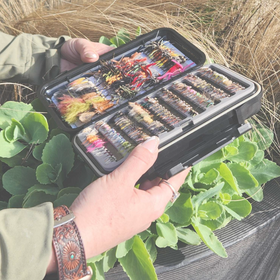 - (photo: www.troutnut.com)
- (photo: www.troutnut.com)
Entomologists classify it differently depending on where they are located. For the excessively curious, if you are on the Battenkill River in Vermont you are talking about the Maccaffertium vicarium and if you are on the Yakima River in Washington you are talking about the Rhithrogena morrisoni. Whatever the entomologists call it, fly fisherman call it the March Brown. Hatching as early as February or as late as June, depending on the location and the severity of the particular winter, it is a big brown mayfly hatch that awakens the senses of trout, and rekindles the trout fly fisher with their passion.
No other mayfly can be quite so anticipated as the March Brown. The first major hatch of the spring season, it signals the end of winter to a fly angler, as much as the coming of a local Hickory Farms signals Christmas. The March Brown is one of the oldest patterns out there, around since the beginning of fly fishing. So it has been that generations of fly angler’s have long awaited the dawning of spring, by designing the dry fly pattern to fool the newly awakened trout.
Nymphs:
The March Brown Nymph belongs in the clinger family of mayfly nymphs. (For more info on the basics of mayfly nymphs, click here). They are found in faster riffles, and can make for great sub-surface fishing in the early stages of the hatch. We produce a pattern called the March Brown nymph, that doubles as a great searching pattern as well. Other popular nymph patterns for the March Brown hatch are the Beadhead March Brown, Hare & Copper, as well as the ever-popular Gold-Ribbed Hare's Ear. Soft Hackle Hare’ Ears are effective as an emerger in the surface film. As mentioned above the March Brown is fairly good sized, use 12-14 nymphs.
 - This is an "Eastern" March Brown nymph, Maccaffertium vicarium. (photo: www.troutnut.com)
- This is an "Eastern" March Brown nymph, Maccaffertium vicarium. (photo: www.troutnut.com) - This is a "Western" March Brown nymph, Rhithrogena morrisoni. (photo: www.troutnut.com)
- This is a "Western" March Brown nymph, Rhithrogena morrisoni. (photo: www.troutnut.com)Adults:
March Brown’s tend to hatch early afternoon, which is nice, since early spring weather can be the most brutal fishing weather of the year. By afternoon the anxious fly fisherman stands a better chance of not being froze off the water. Spinner falls happen right at dusk, and usually occur over fast water. A popular technique has the fly fisher looking downstream for a back eddy or pool that will hold a congregation of March Brown spinners. This often will result in the best March Brown fishing of the season.
 - A "Spinner" Western March Brown, Rhithrogena morrisoni. (photo: www.troutnut.com)
- A "Spinner" Western March Brown, Rhithrogena morrisoni. (photo: www.troutnut.com) - A "Dun" Eastern March Brown, Maccaffertium vicarium (photo: www.troutnut.com)
- A "Dun" Eastern March Brown, Maccaffertium vicarium (photo: www.troutnut.com)The Fishing:
Despite their winter hiatus from feeding, trout seem to emerge in spring a little hesitant. Often times, they may be uncharacteristically selective. Since March Browns are in faster water, it might be difficult to get a read on what the trout are actually doing, if anything. When unsure, I begin with a Soft Hackle Hare’s Ear, right below the surface and see if fish are hitting the emerger. If there is no action, I will then sink the fly or switch to a Beadhead Hare’s Ear, while looking for some surface action.
When it does start up, be prepared it can be short-lived but well worth the effort, especially in the early afternoon. There is often a "spinner fall" in the late evening after the mating dance and the cycle is ending. Look for action in back eddies and big pools for the spinner fall.
Ahh, at last Spring has arrived!




